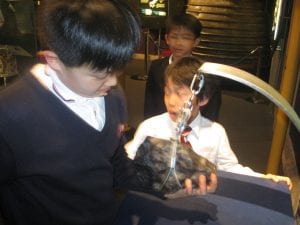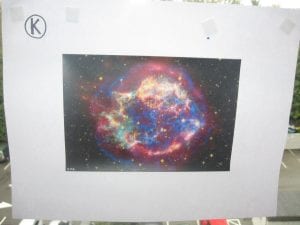

Good day! Let’s start by introducing ourselves: our names are Brian Shin and Michael Alford. We are gr.6 science teachers at St. George’s Junior School in Vancouver, British Columbia, Canada. Our school is an all boys school and has fully embraced the GID model for learning. It is exciting to share our Guided Inquiry Design (GID) experience! Let’s take you through the process!
A unit of study in the B.C. gr.6 science curriculum is ‘The Universe’. The “Big Idea” noted in the curriculum is “The solar system is part of the Milky Way, which is one of billions of galaxies.” With such a large scope of available topics of study, it is easy for students to choose one and research many facts on it. But here is the issue: they end up not really focusing on one key idea, or connecting the student with the content at a much deeper and meaningful level. Thus, the end result of their project is typically a broad, superficial summary. We wanted to change that!
Luckily, there is a great support network at our school to help. Our librarian and faculty have already exposed the boys to this wonderful process, so the steps and expectations were familiar to all learners. Moreover, Leslie Maniotes is incredibly helpful and always available! Her book, Guided Inquiry Design is the ultimate resource, with detailed examples.
Today and the next couple of posts we will provide an account of how we used GID to promote deeper learning and also to provide some reflection on the process; we will review each GID stage and then write some “impressions”.
In the beginning…Open Phase
We thought visual! Boys especially connect with good visuals to stir the imagination.
The hook was to watch the video “The Milky Way HD” by National Geographic(available online) and were provided with a link to finish at home if needed, depending on class time. The boys started a journal here to keep a record of interesting ideas that they felt impressed by.
Impressions: spectacular visual introduction of space; advanced presentation in terms of concepts, that left them excited and curious. Each boy was given a portfolio folder to be kept in class; they also created a google doc that was to be their personal ongoing Inquiry Journal (thank goodness for the automatic saving which is a feature of this program!). Video notes were made in their journal to keep a record of interesting ideas that they felt impressed by. These ideas were shared on post-it notes on the board at video’s end, and the start of next class. Lots to think about!
For us, the most time consuming phase of GID is the Immersion.
The students were now exposed to concepts that continue to build on ideas generated in the Open phase.
What a better way to start to do this than a field trip! The Vancouver Planetarium was an easy choice for sure! Lots of hands on, kinesthetic activities, plus the mind-blowing dome show. Lots to write about for highlights in their journals!

This is hot!

SO heavy!
For the following class lesson photos were posted at points around the classroom. This was a “Gallery Walk” where they held a graphic organizer with columns headed ‘I see’, ‘I think I know’, ‘I wonder’. Listening to tranquil space music streamed from Youtube, and in silence, they took a few minutes at each picture to write in their organizer. The pictures ranged from a Nebula, space technology, birth of stars, etc..Once they made their way through most or all of the gallery, they got into their newly created Inquiry Circles to share important thoughts about the top 2 or 3 intriguing pics for each Circle member. Their portfolio would contain all written materials such as this.

Gallery Walk pic

Gallery walk activity
Building a base of background knowledge in addition to just highlighting key terms and definitions is critical in the Immersion phase. If researching this knowledge is too wide-ranging and individualized, students will not have a common platform to work from; selecting core principles for basic understanding is key. These concepts are chosen by the teacher so the class knowledge is uniform. We decided on an activity called a ‘Jigsaw’ which allows each member of the Inquiry Circle to become an expert on a general concept. Using an online resource such as the ESA – kids website is appropriate for accumulating a base of basic facts and understanding. Each member of the Circle would create a Google slideshow about the concept, and then ‘share’ his google slideshow with all Circle members. The Circle members would read all their ‘shared’ slideshow summaries (the Jigsaw is completed) and write an “I wonder” question in their journal for each. These questions add to the important ideas that the student is gathering. They would also have collected general background knowledge in the form of the slideshows for future reference.
Extreme environments and technology! How easy does it get to engage boys in learning! These topics were the focus for the rest of the Immerse phase. Educational sites offer videos such as the Apollo 13 mission that are actually quite riveting with real footage. Using guided questions and stopping the video frequently to discuss the extreme environment of space coupled with technological challenges, the students found the true story unbelievable! More reflection was written in their journals. Finally, a podcast site called ‘Starspot’ was introduced and one podcast on Electric solar sails was listened to, again with stop and start playing that allowed for discussion and understanding. The boys were asked to draw the technology based on what was described in the podcast. This was added to their portfolio.
Impressions: The longest phase of inquiry for sure! The field trip offered so many connections to topics and brought a tactile quality to the experience. Fun! The extreme environment of space came through clearly in the Apollo 13 video. The introduction of the inquiry circles promoted communication and reflection among peers. Having responsibility to share background knowledge with peers in the jigsaw activity was meaningful and promoted further inquiry through the I Wonder questions. A discussion around using a podcast as a source gave them insight into resource use. The pros of a podcast include the topic is very current and is presented by leading experts in the field. A downside for gr.6 can be the advanced nature of the presentation. Throughout the Immerse phase the boys got continuous feedback on their work to date from the teacher. Using an online school-wide platform called Canvas, we were able to give immediate feedback to their journals without using paper. Their portfolio that did include written handouts was monitored for completion at this stage.
Tomorrow – Explore and Identify!